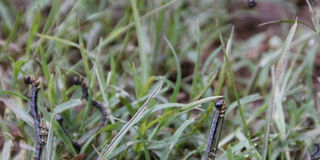Premium
Food security at risk as dreaded pest slips into African countries

Armyworms devour grass at a farm in Ngechek, Mosoriot in Nandi County in May last year. Researchers tracking the crop-destroying caterpillar say it is now spreading rapidly across mainland Africa and could reach tropical Asia and the Mediterranean in the next few years, threatening agricultural trade. PHOTO| FILE| NATION MEDIA GROUP
Scientists are calling for urgent action to contain the spread of a pest that is destroying maize crops and spreading rapidly across Africa.
Researchers tracking a crop-destroying caterpillar known as the fall armyworm say it is now spreading rapidly across mainland Africa and could reach tropical Asia and the Mediterranean in the next few years, threatening agricultural trade.
The fall armyworm moth has dark-gray, mottled forewings with light and dark splotches, and a noticeable white spot near the extreme end of each.
Given that it can be one of the more difficult insect pests to control in field corn as it destroys young maize plants, attacking their growing points and burrowing into the cobs, the Centre for Agriculture and Biosciences International (Cabi) is warning that the pest poses a major threat to food security.
Once established in an area, the adult moths can fly large distances and spread rapidly. The FAO is to hold an emergency meeting in Harare between today and Thursday to decide emergency responses to the threat.
Plant doctors working in Cabi’s Plantwise clinics, aimed at helping farmers lose less of what they grow, have found evidence of two species of fall armyworm in Ghana for the first time, and researchers are now working to understand how it got there, how it spreads, and how farmers can control it in an environmentally friendly way.
Cabi chief scientist, Dr Matthew Cock, said: “We are now able to confirm that the fall armyworm is spreading very rapidly outside the Americas, and it can be expected to spread to the limits of suitable African habitat within just a few years. This is the first time it has been shown that both species or strains are established on mainland Africa.”
TRAVELLED TO AFRICA AS ADULTS
The pest most likely travelled to Africa as adults or egg masses on direct commercial flights and has since been spread within Africa by its own strong flight ability and carried as a contaminant on crop produce, said Mr Cock.
The armyworm is native to North and South America. The caterpillar gained its name from the fact that it eats its way through most of the vegetation in its way as it marches through crops.
While it mainly affects maize, it has also been noted to eat more than 100 different plant species, such as rice and sugarcane, as well as cabbage, beet and soybeans.
Damage to maize crops was investigated at three different survey areas within Ghana and the caterpillars associated with the damage were photographed, collected, and sent to the Cabi laboratory in Egham, UK, for analysis.
Once samples are received in the lab, a small portion of each caterpillar is removed for molecular testing. DNA is isolated from the cells, and a specific gene is amplified, sequenced, then compared against authenticated ‘barcode’ sequences for definitive identification.
Suspected outbreaks have already erupted in Zambia, Zimbabwe, Malawi and South Africa, and the UN Food and Agriculture Organisation (FAO) last week said the pest had spread to Namibia and Mozambique, prompting the agency to plan emergency talks to figure out how to combat it.
Once established in an area, the adult moths can fly large distances and spread rapidly. The FAO is to hold an emergency meeting in Harare between today and Thursday to decide emergency responses to the threat.



